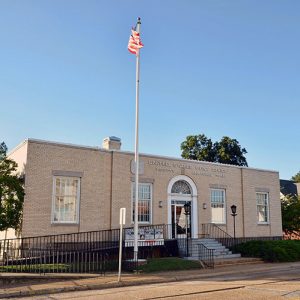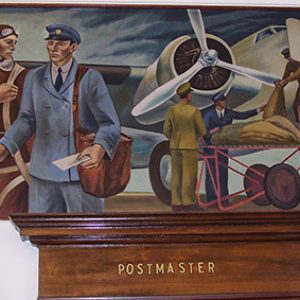calsfoundation@cals.org
Piggott Post Office
The Piggott Post Office at 119 North Third Street in Piggott (Clay County) is a one-story, brick-masonry building constructed in 1937–38 and featuring a mural created through the U.S. Treasury Department’s Section of Painting and Sculpture (later renamed the Section of Fine Arts), a Depression-era stimulus project that promoted public art. The post office was listed on the National Register of Historic Places on August 14, 1998.
Little documentation exists regarding the building of the Piggott Post Office, but by the time construction on the new Piggott Post Office was three-quarters complete on November 1, 1937, the Section decided to seek permission to commission a mural for the building. According to a December 17, 1937, memo from the Section to the director of procurement, $57,400 had been obligated for the post office, and $700 of that was reserved for mural production.
Based on the merits of a design submitted for a post office in Ames, Iowa, Ed Rowan, Section superintendent, invited artist Lowell Houser to submit designs for the Piggott Post Office on August 20, 1938. Houser accepted the Piggott commission, explaining that he was also teaching at San Diego State College and designing sculptural panels for the Bankers Life Building in Des Moines, Iowa, but pledging “to paint it within the following six months.” However, after nearly two years of delays, Rowan canceled Houser’s contract.
Rowan turned to another Iowan, Dan Rhodes. Rhodes agreed on August 21, 1940, to submit a design, which he did on November 4. “As you will note, I have chosen as subject matter the Air Mail. I feel the Air Mail is of unusual significance to the smaller and more isolated community, linking them as it does with the most distance centers,” Rhodes wrote. “I have tried to convey the sense of stream-lined power which is behind the mail service.” Karal Ann Marling, in Wall-to-Wall America, found that Rhodes’s “image of flight had an almost purely symbolic significance for Piggott in any case. Rhodes’s aircraft bore a striking resemblance to the new DC-3, the first airliner to turn a profit on passenger service without dependence on federal mail contracts; the DC-3 rarely touched down in the northernmost corner of Arkansas.”
Rowan found Rhodes’s subject matter “excellent,” though he had a few suggestions for improving the proposed mural’s balance. The official contract was dated November 18, 1941, and Rhodes received his first $150 payment on the $700 job on January 22, 1941. A second payment of $225 was authorized on February 6, the same day Rhodes received permission to install the mural in Piggott.
Piggott’s postmaster Ralph McNiel wrote Rowan on March 11, 1941, that the mural was both satisfactory and installed but complained that “the molding around the mural has not been painted; and the wall surface between the decoration and bulletin boards is somewhat soiled, the same having been done while the surface was being cleaned for the proper installation of the mural.” The mural was pictured in the March 11, 1941, St. Louis Post-Dispatch, a clipping of which was enclosed in McNiel’s letter.
On March 25, 1941, Rhodes was paid the $325 balance due on his contract, ending the more than three-year effort to place a mural in the Piggott Post Office. The mural remains there today, in a building that retains virtually all of its original character and continues to serve the people of Piggott.
For additional information:
“Arkansas Post Office Murals.” University of Central Arkansas. http://uca.edu/postofficemurals/home/ (accessed October 7, 2020).
Marling, Karal Ann. Wall-to-Wall America: A Cultural History of Post-Office Murals in the Great Depression. Minneapolis: University of Minnesota Press, 1982.
“Piggott Post Office.” National Register of Historic Places nomination form. On file at Arkansas Historic Preservation Program, Little Rock, Arkansas. Online at http://www.arkansaspreservation.com/National-Register-Listings/PDF/CY0033.nr.pdf (accessed October 7, 2020).
Smith, Sandra Taylor, and Mark K. Christ. Arkansas Post Offices and the Treasury Department’s Section Art Program, 1938-1942. Little Rock: Arkansas Historic Preservation Program, 1998. Online at http://www.arkansaspreservation.com/News-and-Events/publications (accessed July 12, 2016).
Mark K. Christ
Arkansas Historic Preservation Program
 Early Twentieth Century, 1901 through 1940
Early Twentieth Century, 1901 through 1940 Historic Preservation
Historic Preservation Piggott Post Office
Piggott Post Office  Piggott Post Office Art
Piggott Post Office Art 



Comments
No comments on this entry yet.